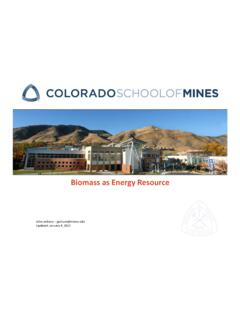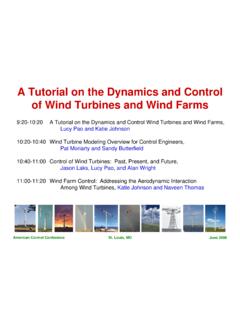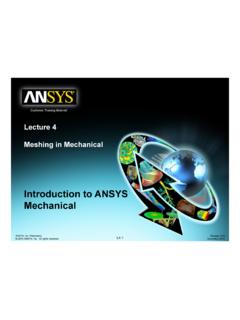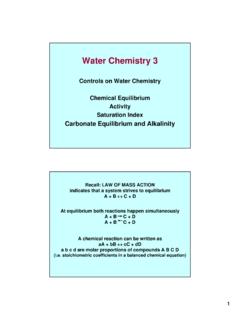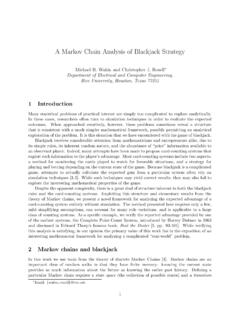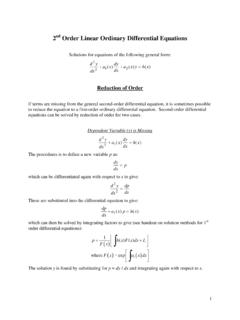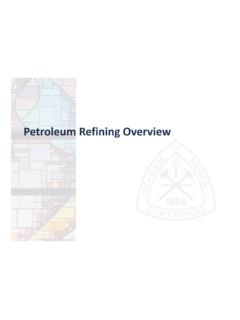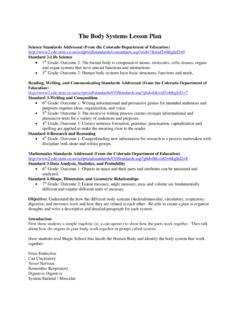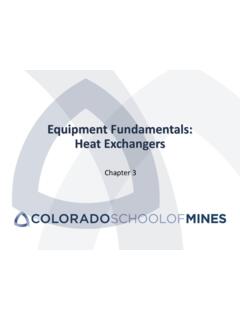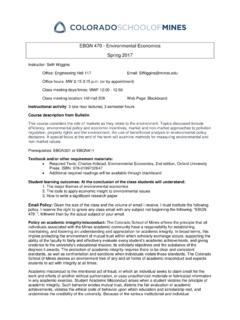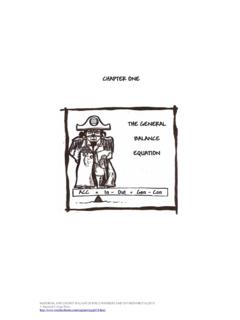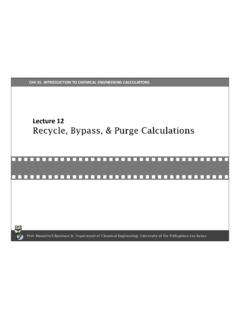Transcription of Colorado School of Mines CHEN403 Mathematical Models ...
1 Colorado School of Mines CHEN403 Mathematical Models John Jechura - 1 - Copyright 2017 April 23, 2017 Setting up the Mathematical Model Review of Heat & Material Balances Topic Summary .. 1 Introduction .. 2 Conservation Equations .. 3 Use of Intrinsic Variables .. 4 Well-Mixed Systems .. 4 Conservation of Total Mass: .. 4 Component Balances .. 5 Energy balance: .. 5 Additional Relationships .. 6 Exceptions to Well-Mixed Process Assumptions .. 8 Processes with Dead Time .. 8 Flow Approximated by Combination of Well-Mixed Blocks .. 8 Examples .. 9 Tank Liquid Level with Flow Through 9 State Variables: .. 9 Total Mass Balance Leads to a Volume Balance: .. 9 Other Tank Geometries .. 10 Right Circular Cone .. 10 Horizontal Cylinder .. 10 Tank flow Change in Inlet Concentration .. 11 Overall & Component Mass Balances.
2 11 Component Material Balance: .. 12 Using Concentration .. 12 Using Mass Fraction .. 12 Tank Flow Chemical Reaction .. 13 Tank Flow Change in Input Stream s Temperature .. 14 State Variables: .. 15 Initial state:.. 15 Transient solutions .. 15 What if the heat input is described by Newton s law?.. 16 Example Tank Flow Controlled by Valve .. 17 Bernoulli s Law: .. 17 Total mass balance reduces to volume balance for constant density: .. 18 Example: Chemical 19 Topic Summary Definition of well-mixed system. Combining well-mixed sub-processes to describe overall process that is not well-mixed. Colorado School of Mines CHEN403 Mathematical Models John Jechura - 2 - Copyright 2017 April 23, 2017 Dynamic equations from material & energy balance equations Typical simplifications & modifications Additional relationships We will show that certain dynamic relations typically come most directly from certain conservation equations.
3 These typical relationships are shown in the following table. Conservation Equation Typical Dynamic Relation Overall Material Balance Outlet volumetric flowrates vs. inlet rates Liquid: Liquid level in system vs. time Gas: Gas pressure in system vs. time Component Balance Outlet concentration vs. time Outlet mole/mass fraction vs. time Thermal Energy Balance Outlet temperature vs. time Introduction Transient behavior of a process: Start up. Steady state random disturbances. Change of set points. Shut down. Steps for math modeling: Develop the relationships/equations. Simplify. Solve: Analytical Laplace transforms Numerial Euler, Runge-Kutte methods Needs of math model: Quantities whose values describe the nature of the process. These are the state variables. Equations that use the quantities & describe how the variables change with time.
4 For algebraic equations, where N is the number of variables & E is the number of independent equations: EN, deterministic system. EN, under-determined system. EN, over-determined system. Colorado School of Mines CHEN403 Mathematical Models John Jechura - 3 - Copyright 2017 April 23, 2017 For differential conditions, also need boundary conditions. For transient problems, these are normally initial conditions. We will mostly be working with lumped systems , there will be no spatial variation. Often termed as a well-mixed system. Conservation Equations We will use the basic principles of chemical engineering to guide us in our descriptions of our dynamic processes: conservation of mass, energy, & momentum. So, the types of conservation equations will be: The overall mass balance. Component/chemical species balance (including reaction rate terms).
5 Thermal energy/heat balance. Momentum balance (though we won t usually work with this in this class). General form of the stuff balance equation: Rate ofRateRateRate ofRate ofAccumulationInOutGenerationConsumption Basic principles of ChE: F1F3F4F5F6Q1Q2Q3F2 Summary of the balance equations: Overall Mass Balance ::iji inletj outletdmmmdt Component Balance AA ,A ,:::ijki inletj outletk rxnsdmmmR Vdt Colorado School of Mines CHEN403 Mathematical Models John Jechura - 4 - Copyright 2017 April 23, 2017 AA ,A ,:::ijki inletj outletk rxnsdNNNr Vdt Energy Balance ,::ijks mi inletj outletkmdEEEQWdt Use of Intrinsic Variables It is useful to factor out intrinsic variables properties that depend upon the state of the system (pressure, temperature, phase condition) but not the magnitude.
6 It is often convenient to use the product of the mass density and volumetric flowrate instead of the mass flowrate. Some of the useful relationships will be: Cumulative Expression Rate Expression Mass mV mF Moles totalnVCV totalnFCF Energy EmEVE EmEFE Enthalpy totalHmHVHnHCVH totalHmHFHnHCFH Well-Mixed Systems The intrinsic properties of the system at any point will be the same. Added implication every outlet stream will possess the same intrinsic properties as the system itself. The intrinsic properties of the inlets can still be independent. Conservation of Total Mass: ::iji inletj outletdmmmdt ::iijji inletj outletddVFFdt (use the intrinsic variable ) ::iiji inletj outletdVFFdt (well-mixed system) where iF is a volumetric flow rate (in or out).
7 Note that all outlet streams will have the same density as the density within the system s volume. Conservation of total moles? NO! When there is a chemical reaction the total number of moles may not necessarily be conserved. Colorado School of Mines CHEN403 Mathematical Models John Jechura - 5 - Copyright 2017 April 23, 2017 Component Balances The component balances can be expressed either in terms of mass (and mass fraction): AA ,A ,A:::ijki inletj outletk rxnsdmmmR dVdt AA ,A ,A:::iiijjjki inletj outletk rxnsddVFFR dVdt AA ,AA:::iiijki inletj outletk rxnsdVFFR dVdt or in terms of moles (and molar concentration, though mole fractions could also be used): ,,A:::AA iA jki inletj outletk rxnsdNNNr dVdt AA ,A ,A:::iijjki inletj outletk rxnsdc dVc FcFr dVdt AA ,AA.
8 Iijki inletj outletk rxnsd c Vc Fc Fr Vdt where kR is the mass reaction rate expression (kg A per unit time per unit volume) and kr is the molar reaction rate expression (moles A per unit time per unit volume). It is usually easier to work with moles when there is a chemical reaction. Note that the reaction term can be positive for generation & negative for consumption. Energy balance: ,::ijks mi inletj outletkmdEEEQWdt P,::,:: iijjks mi inletj outletkmiiijjjks mi inletj outletkmd UKw Hw HQWdtF HF HQW where iH is the specific enthalpy (per unit mass). The energy balance can also be put on a molar basis: Colorado School of Mines CHEN403 Mathematical Models John Jechura - 6 - Copyright 2017 April 23, 2017 P,::iijjks mi inletj outletkmd UKN HN HQWdt where iH is the specific enthalpy per unit mole basis.
9 There are additional assumptions normally made to the energy balance: P,:: iiijjjks mi inletj outletkmd UKF HF HQWdt ,:: iiijjjks mi inletj outletkmdUF HF HQWdt (internal energy dominant term) For liquid systems we will generally use the assumption that UH: ,:: iiijjjks mi inletj outletkmdHF HF HQWdt ,:: iiijjjks mi inletj outletkmdHdVF HF HQWdt ,:: iiijks mi inletj outletkmdHVF HF HQWdt (well-mixed). For gas systems this is not necessarily the case. However, since we ultimately want a dynamic expression for temperature this is not a significant problem. ,:: iiijjjks mi inletj outletkmdUdVF HF HQWdt ,:: iiijks mi inletj outletkmdUVF HF HQWdt (well-mixed). Additional Relationships These are the basic equations, but now we also need relationships to the measured process variables.
10 Relationship between mass & volume: mVAh (for constant cross sectional area) mF Colorado School of Mines CHEN403 Mathematical Models John Jechura - 7 - Copyright 2017 April 23, 2017 Thermodynamic relationships: refrefTprefpprefTPTrefpprefTHCHHC dTC TTTHHC dTC TT UHPVH (for liquid systems) UHRT (for ideal gas systems) Equations of state relating density to pressure, temperature, & composition: ,,TPx (the equation of state). Some simple equations of state: iiiPMPxMRTRT (ideal gas) 11iiiiiiixMM (ideal volume of mixing/additive volumes) Energy relationships: 221122 KmvVv P00mg h hVg h h (gravitational potential energy. May be other forms) Relationship between heat transfer rate & temperature driving force: aQUA TT (Newton s law of heating/cooling) 4411 112 2 QATT (Kirschoff s law of radiant heat exchange) Relationship between flow through a valve & pressure driving force: pvFpFApCh (non-linear valve flow expression) Chemical reaction rate relationships: ,,AArr TPx (the reaction rate function).
